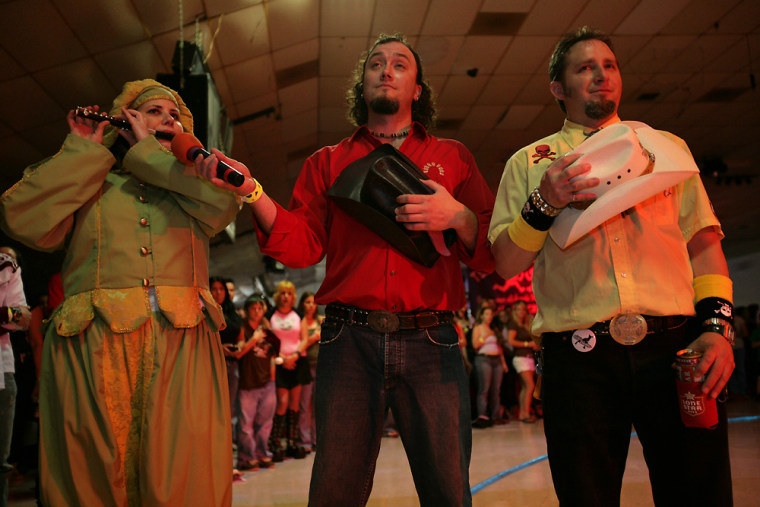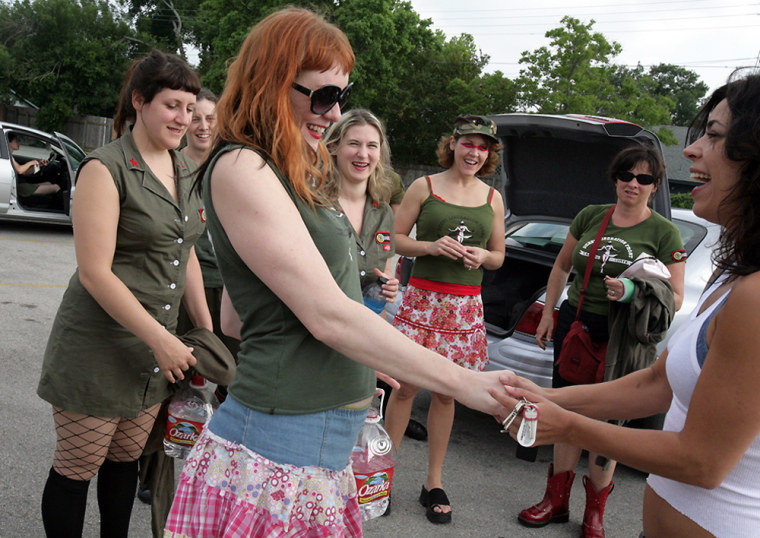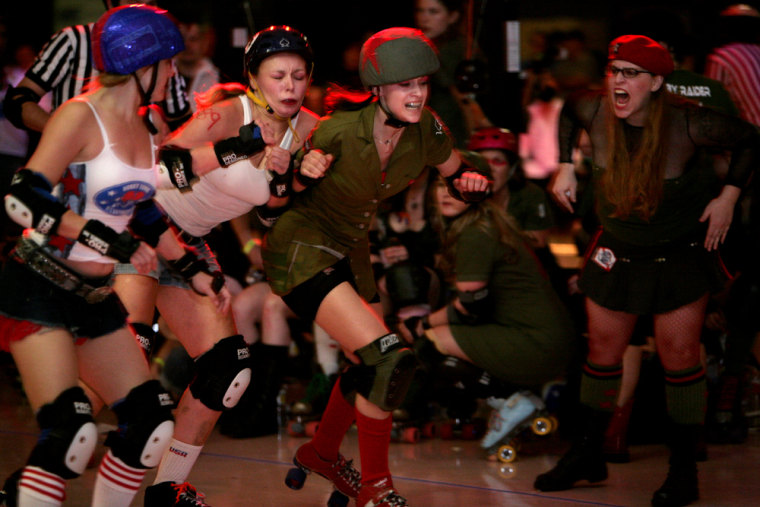AUSTIN, Texas — Donning red fishnets and olive drab miniskirts, the women of Seattle’s Derby Liberation Front roll onto the track raising revolutionary fists in the air. The team’s mascot, Dr. Five, strides across the arena in fatigues, mirrored sunglasses and a red beret. It’s showdown time at Playland Skate Center.
In the lineup are Kim Reaper, D-Bomb, Sybil Unrest and Ann R. Kissed — who as a newcomer is considered “fresh meat” on this team. Two key players — Burnett Down (injured) and Captain Lorna Boom (pregnant) — are on the sidelines, worsening the team's already poor odds against the more seasoned Honky Tonk Heartbreakers of Austin.
"We're up against what is probably the best team in the world," says Ida Slapter, aka Meghan Smith, who has been known to show up for her day job as a receptionist with her nose out of joint and sporting a shiner. "They're very, very aggressive."
Despite Ida’s misgivings, the Derby Liberation Front proves itself a scrappy and determined underdog. Overcoming a series of missteps — rules breaches that land its skaters in a mock electric chair serving as the penalty box — they surge in the second-half and nearly topple the Texas team.
Yes, roller derby is back. A new generation of women has rehabilitated, and adapted the rowdy, raucous sport that rolled into obscurity in the 1970s. There are 30 new leagues — nearly 100 teams — competing within the two-year-old Women's Flat-Track Derby Association. About 60 more leagues are starting up across the United States, according to the WFTDA.
The audiences are growing too.
On this night in Austin, hundreds of fans crowd into the Playland arena at $15 a ticket to see the inter-league bout between the Derby Liberation Front and the Honky Tonk Heartbreakers, the reigning champions of roller derby.
The buzz over what remains a women-only phenomenon isn’t confined to Texas, the birthplace of the Roller Derby revival.
The Derby Liberation Front's league — the Rat City Rollers, which is only in its second year of competition -- recently sold out a 1,500-seat arena outside Seattle for an exhibition match. The same sense of excitement is filling skating arenas in Gotham City, the Windy City, Sin City, the Twin Cities and elsewhere.
Is it show, or is it sport?
One of the roller derby's charms is its improbable blend of real athleticism with high camp.
"The draw is part sex (appeal), part sport, part freak show," says Ziv Kruger, a music lawyer in Austin who also is a volunteer photographer for the Texas league. "Everyone goes for their own initial motive, but most develop a second relationship with the league — and that's as sport fans, like any other sport has."
Roller derby was created in 1932 by entrepreneur Leo Seltzer, who conceived of it as an endurance competition in a period when dance-a-thons were all the rage. The theatrical violence and other antics that became the hallmark of the game were added by a rival derby outfit in an effort to lure crowds.
Despite such attention-grabbing tactics, roller derby petered out by the early 1970s. An attempt to revive it by a 1980s television show “Roller Jam,” which injected a new element of danger by adding a pit of live alligators in the center of the track, was short-lived.
Its current incarnation traces to the 2001 formation of the Texas Rollergirls league, which grew into a legal nonprofit organization in 2003.
"We knew we had to do something when we suddenly had more money than you could stuff into a panty drawer," says Michelle Bowlin, a member of the Hotrod Honeys known as “Eight Track” and a certified public accountant who helps manage finances for both the Texas Rollergirls and the national association.
The sport embraces some of the retro aspects of the old roller derby, including the use of "quads" — the old style four-wheeled roller skates.
But this is not your mother’s roller derby.
Spectacle vs. sport
The announcer’s box, the pre-game show and the sidelines feature screeching rock bands and a parade of outlandish characters. At one recent bout, a bleach-blonde drag queen dressed in white cowboy boots lip-synched the national anthem as a man in a wheelchair bearing the American flag did a series of 360s as he circled the track. During the match, a half-Elvis, half-monkey — a mascot for the Sockit Wenches — made a great show of scratching his privates, evoking a roar of groans from the crowd.
Some skaters choose to project a specific persona beyond the team identity — like the Derby Liberation Front’s mommacherry, who fashions herself as an angry housewife, wearing a frilly apron and carrying a baking pan during the pre-game warm-up.
Her history, according to her official bio, goes like this: “While organizing a PTA rummage sale she came across a worn copy of Abbie Hoffman’s “Steal this Book” and a pair of roller skates. It was enough. Mommacherry packed up her daughter and her recipe books and she left the suburbs in search of the revolution.”
And then there are fights, which are theatrical, but according to the skaters, not scripted.
The spectacle has triggered an ongoing debate over the proper mix of show and sport in the game.
"We had to meld the two together and make something that could make everybody happy," says Bowlin.

But she says new teams coming into the league are pushing the athletic side over the theatrics.
"It's weird because we're like the elders... At the same time, it's all the other new leagues that have forced us to step up our game to a completely different realm," she says. "You can't go there with... all that funny jujitsu stuff where you flip people over and whatnot. We have to play for real against these women!"
Jamming, whipping, blocking and bruising
At its heart, roller derby is a game that requires speed, strategy, endurance and some robust padding. To play a bout, each team fields five skaters at a time in a series of races — called jams — that last up to two minutes apiece.
There are three positions on each side:
- A “pivot,” who skates at the front of the pack and sets the pace for her teammates.
- A “jammer,” who starts at the back and scores a point for her team each time she laps a member of the opposing team.
- “Blockers,” three to a team, make up the central pack and attempt to prevent the opposing team’s jammer from passing while simultaneously trying to open up a pathway for their own jammer.
At times, a blocker will reach back and grab the hand of her jammer and fling her forward past the opposition — known as “giving a whip” in derby lingo. Players also will yell at teammates to “pack it up,” or tighten up their defenses.
While flattening players on the opposing team with a walloping body check — known as a “take-down” — is not the main goal, there are legal ways and strategic reasons for doing so. For one thing, it makes them easier to pass.
The maneuver also can lead to one of the most prevalent derby-specific injuries — rink rash, which sometimes takes the particularly painful form known to some as “fishnet burn.”
Warnings are doled out for minor infractions, like false starts and skating out of bounds, whereas “gross unsports-ladylike conduct,” tripping, biting and fighting warrant a "major" penalty — a minute in the penalty box. And choking a skater with her helmet strap is expressly forbidden.
But there is a time for teaching a lesson, participants say.
"If someone starts a fight with you, I don't expect you to walk away," Alyssa Hoppe, aka captain Lorna Boom, told other DLF skaters at one Sunday afternoon practice. "Get underneath, hide your punches and make sure they don't do it again. ... Kick the s--- out of them, but just don't get caught."
The fast and the furious
To hear the players describe it, roller derby addresses some needs that are left unfulfilled by, say, an afternoon at the yoga studio or tennis club.
"Roller derby saved my life," declares Sandra Darling, aka mommacherry, a single mom, former stripper and ex-Navy wife who credits the game with a 50-pound weight loss and rescue from the deadly boredom of her more conventional past.
“It’s definitely an alter-ego,” agrees teammate Lisa Leisle, an insurance claims adjuster, mom and wife who skates under the name Punchin’ Judy. A passionate convert to the game since last year, she styles her hair so that it curls up in a tidy flip around her helmet during the bout. “You get to do all the things girls aren’t supposed to do.”
For some players, especially jammers, the thrill is in speed, and some of the players come from a speed-skating background.

But roller derby also attracts women who have never competed on a team before, and some who haven't skated much. One reason is that teams need a variety of body types, including bigger women who may not be as fast, but can block.
Character is a factor, too. “I can say ‘OK, you’ve got the right personality’,” says Hoppe, the DLF captain. “Even if your skating skills are not that great … I can teach you to skate.”
Do-it-yourself derby
Flat track derby is evolving, and it could still die off like its predecessors. But this time it has a grass-roots quality that suggests it won't. The teams and leagues are run by the players, who pay dues and dedicate long hours to workouts and strategy. They decide by vote how to spend money — including which charities to help.
The track itself was designed by a Texas Rollergirls player, who used AutoCAD design software to adapt the banked track to a flat surface, widening the track to allow for skaters' centrifugal force.
Bowlin says the flat-track game turns out to be rougher, and more exciting for fans, who can sit closer to the action, though they also run the risk of getting flattened by a runaway roller girl.
The logistics of flat-track are easier to manage too, allowing new roller derby teams to spring up in typical suburban skating arenas. Indeed, the Texas Rollergirls broke away from a group called Bad Girl Good Woman Productions that chose to play on an old banked track. The flat-track version quickly outgrew their predecessor, which today has only a handful of leagues.
Under the WFTDA, derby leagues have created a unified set of rules and set up a network to help new leagues get started, and build a fan base.
Having the Derby Liberation Front on the track in Austin for the younger team's first inter-league competition is yet another sign that the sport is gaining momentum, according to Bowlin, though she concedes it is still a long way to the front of the Wheaties box.
"But then the major majority of us really don't care," says Bowlin. "If we can skate and comfortably pay our (team’s) bills, we're pretty much happy."
